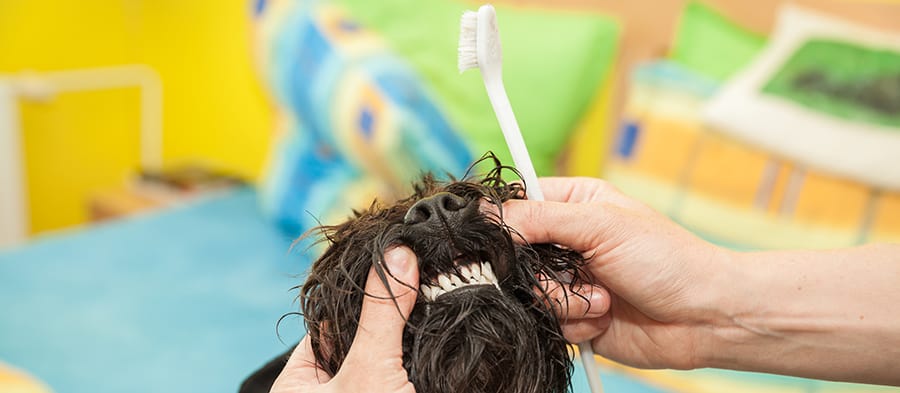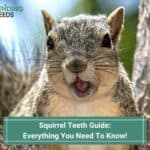Labradoodle puppies, like all other puppies, enjoy exploring their environment. When they’re really young, much of this exploration is done with their mouths. And those sharp little puppy teeth of theirs sometimes find their way to your fingers, toes, and even your clothes. So it’s no wonder people are anxious for those pokey needly things to fall out.
So, when do Labradoodle puppies start to lose their teeth? They typically begin losing their puppy teeth around 3 to 4 months old. As the teeth fall out, they will be replaced by your puppies permanent adult teeth. All of their puppy teeth should be gone by 6 months. If puppy teeth still remain at 6 months, be sure to consult with your Veterinarian.
Puppy Teething Timeline
- 3 weeks old – Baby teeth start coming in.
- 6 weeks old – Most baby teeth have broken through.
- 8 weeks old – All baby teeth have come in.
- 3 months old – Puppy can absorb the baby teeth roots.
- 4 months old – Baby teeth start to become loose and begin falling out.
- 6 months old – All baby teeth should be gone and adult teeth are coming in.
- 8 months old – All adult teeth should be in.
You may start noticing your puppy’s teeth are missing but the teeth are nowhere to be found. This is because they often times fall out while they’re eating or chewing on a toy. So sometimes they will actually eat their teeth unknowingly. Don’t worry — this is normal.
When Should You Start Brushing Your Dog’s Teeth?
There is a significant link between dental health and the overall health of your pup. So good dental care for your Labradoodle puppy should begin as early in his life as possible. This is not to say you should begin brushing his teeth at the first sign of baby teeth in his mouth. However, you should begin touching your puppy’s mouth and teeth at this age so he or she becomes accustomed to having this done on a regular basis.
We recommend brushing your puppies teeth from the moment you bring them home; usually around 8 weeks. This is the puppy brushing kit I started with. If you start this early, and keep up with a consistent brushing routine, by the time their adult teeth have grown in, they’ll be used to the brushing process.
Here are some basic dog brushing tips:
- Use canine toothpaste. My Labradoodle Oliver loves this toothpaste.
- Use a canine toothbrush with soft bristles. These are the ones I use.
- Replace the toothbrush when bristles are frayed or about every 3 months.
- Brush at least 3 times per week, daily is optimal.
- Always end the session with praise and a treat.
How To Brush Your Labradoodle’s Teeth
Brushing your dog’s teeth may seem like a real challenge because many dogs are very protective of their mouth and don’t take kindly to someone forcing their mouth open for any reason. Brushing your puppy’s teeth can be much less of a challenge if you start doing it when they’re still a very young puppy. Don’t expect to actually brush your puppy’s teeth the first couple of times you put the toothbrush in his mouth.
Their Mouth
Before you actually begin brushing your puppy’s teeth, you need him to get used to having his mouth and muzzle touched. Try putting a healthy treat like peanut butter on your finger. Allow him to lick it while you gently rub his gums and teeth. Get him used to having his muzzle and mouth touched. Put one hand on the top of this mouth and one on the bottom and leave them there for a few seconds.
Their Teeth and Gums
Once he gets used to that, gently separate his lips and open his mouth. Don’t be at all surprised if the puppy does not like this the first couple of times. This is a trust-building process, and it will take a few times for your puppy to get used to this procedure, which is why it’s important to start this at a young age. When your puppy becomes accustomed to having his mouth opened and his teeth touched, you’re ready to introduce the toothbrush and toothpaste.
Time To Brush
Here are some tips to get the tooth brushing process going as easy as possible.
- When first starting, allow your puppy to smell and lick the toothbrush and toothpaste before you begin.
- Gently move the puppy’s lips aside and rub the visible teeth with the toothbrush.
- Start with just the front teeth at first.
- Start by brushing only a couple of teeth at a time. When the puppy accepts that, increase the number of teeth.
- Reapply toothpaste when needed. If your puppy happens to like the flavor of the toothpaste, he may eat it rather quickly.
- Brush in a circular motion along the gum line where bacteria and food rests.
- When the puppy is OK with this, move on to the back teeth.
- When all is finished, give your puppy a treat so he’ll recognize tooth-brushing time as a pleasant experience.
When I first started introducing Oliver to the brushing process, I started by using a Finger Brush. The finger brush is great because it’s small, easy-to-use, and gently on their teeth and gums. I actually used this for the first month of brushing before switching to an actual dog toothbrush.
Fun fact: You don’t need to worry so much about the inside of their teeth (the side closest to their tongue) because their tongue tends to clean that for them.
Don’t be surprised or frustrated if it takes several attempts before your Labradoodle puppy allows you to brush his teeth. When your pup is accepting of your fingers or the brush inside his mouth praise him and pet him so he feels your love and approval of his good behavior.
Once you’ve gotten to the point where you can actually brush all the dog’s teeth, the whole process of brushing your dog’s teeth should only take about a minute. If your puppy doesn’t respond as well as you’d like at first, don’t scold or yell at him. Be patient and try again later or another day. Above all, you do not want your puppy to look at this activity in a negative light. Nothing makes dogs happier than when they know their master is happy with them.
The impact of oral health on your dog’s overall health
Good oral health is very important for your dog’s overall health. You’re not just brushing their teeth and providing good oral health so their teeth look pretty when they smile. You’re doing it to prevent cavities, periodontal disease, and other dental issues. Humans are not the only ones who suffer from tooth decay, gum diseases, and toothaches.
Dogs can get toothaches, too. However, because they can’t talk, they can’t tell us when their teeth hurt or their mouth is in pain. Veterinarians state that around 85% of dogs over the age of 4 suffer some form of periodontal disease, and 80% show some indications of gum disease by the time they’re 2 years old. The best way to eliminate these problems is to prevent them from developing. Good dental health is the best method of prevention.
Periodontal disease can lead to infection, tooth loss and extreme pain for the dog. If a dog has teeth, gum or mouth problems, it can him cranky or have no desire to eat, which can lead to other health issues. Poisonous gases from periodontal disease can get into the dog’s bloodstream and can lead to kidney, live and heart diseases.
Providing your Labradoodle puppy with good oral health can drastically decrease the chances of your pup having mouth problems and can lead to better overall health. Experts claim that good dental health can prolong your dog’s life expectancy by five years. In addition to brushing your dog’s teeth, you should also have him checked by a vet once a year.
Signs of Oral Health Problems
Often we know our dog is suffering from a health issue because it’s a visible problem or by the way they’re behaving. Oral health problems are not always that easy to spot, which can result in them getting worse before they can better. Here are some signs your Labradoodle puppy may have oral health issues going on.
- Foul breath
- Build-up of bacteria, saliva and food on the teeth
- Excessive plaque
- A hard brown or yellow residue (tartar) on teeth
- Bleeding, swollen or irritated gums
- No desire to eat
- Shows signs of discomfort or pain when chewing
If you happen to notice any of these symptoms, you should talk with your Veterinarian. Work with them to get a plan in place to reduce or eliminate the issues. The best solution, of course, is to prevent these problems from occurring in the first place. Brush your pup’s teeth.
Related Questions
How many teeth do dogs have?
Puppies have 28 baby teeth, and adult dogs have 42 teeth.
What kind of toothpaste should I use for my puppy? Can I use human toothpaste?
You should use a canine toothbrush and canine toothpaste for your dog. DO NOT use human toothpaste. Unlike canine toothpaste, human toothpaste contains additives like fluoride, and should not be swallowed.
What are the best chew toys for cleaning teeth?
You should try to brush your Labradoodle’s teeth at least 3 times a week, although daily is ideal. In addition, you may want to get him some healthy chew toys designed for cleaning teeth. Kong® toys or Gumabones® are a great place to start.
Well, That’s A Wrap!
As frustrating as it may be to get through your Labradoodle’s puppy teething and chewing on everything phase, their baby teeth are soon gone and replaced by permanent adult canine teeth. It’s really important that you make dental care a top priority for your pup since it plays a huge role in their overall health and longevity. They can’t do it without you!





